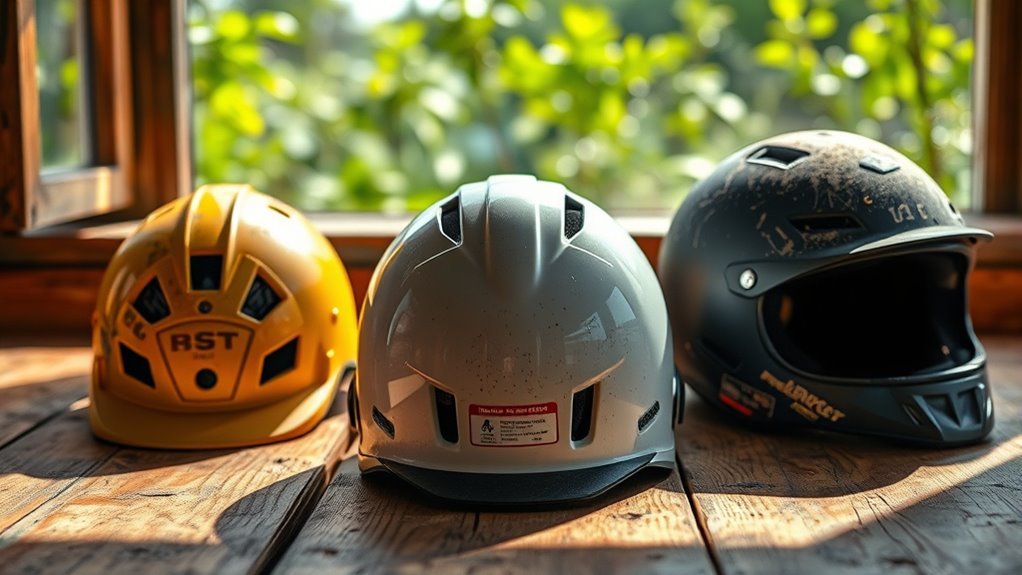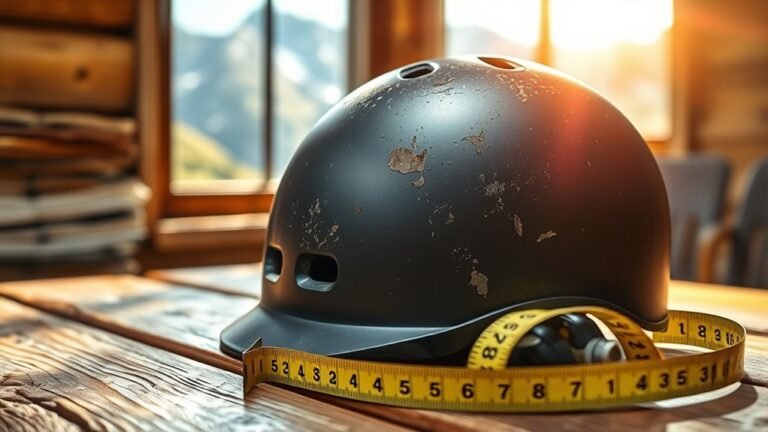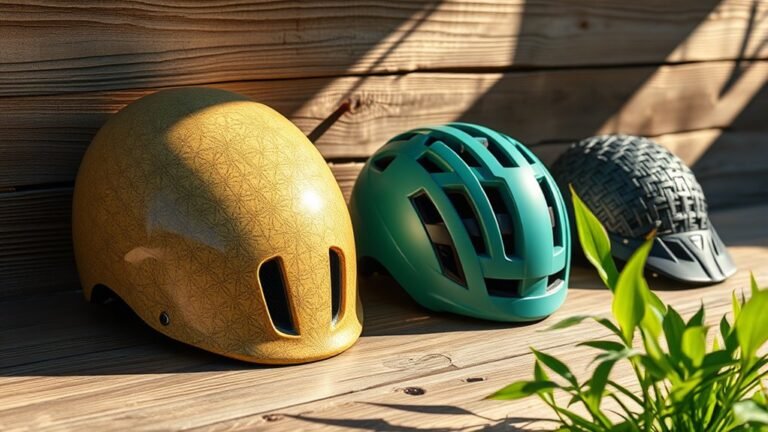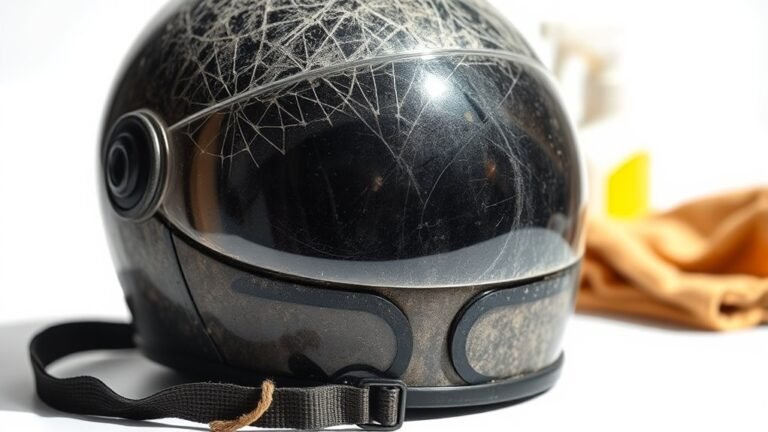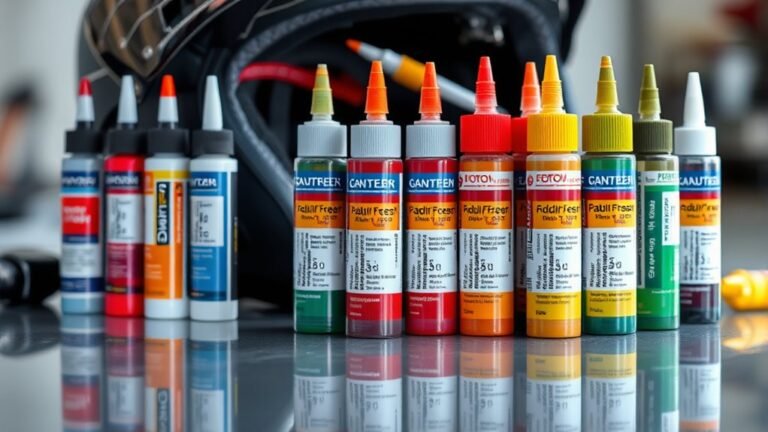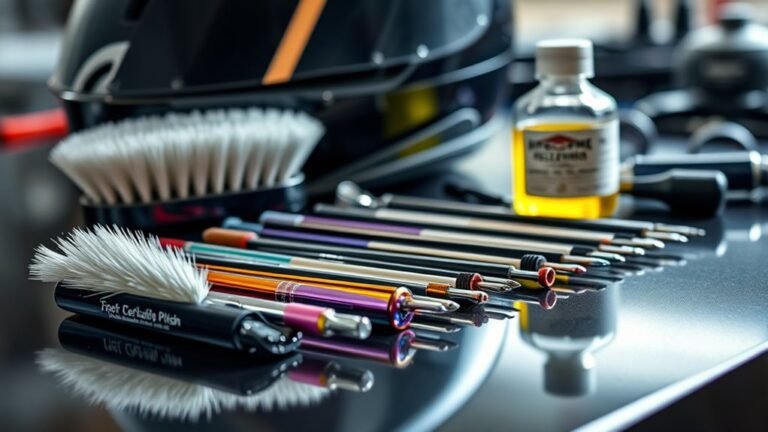When to Replace Your Helmet: A Guide to Lifespan
You should replace your helmet every 3 to 5 years, depending on wear and usage. Look for visible signs of damage, such as cracks or fraying straps, as these indicate that it’s time for a new helmet. Even minor impacts can harm a helmet’s integrity, so consider immediate replacement after any significant hit. Make sure your helmet meets current safety standards and fits securely for maximum protection. Discover more about helmet maintenance and selection for safety enhancements.
Understanding Helmet Lifespan
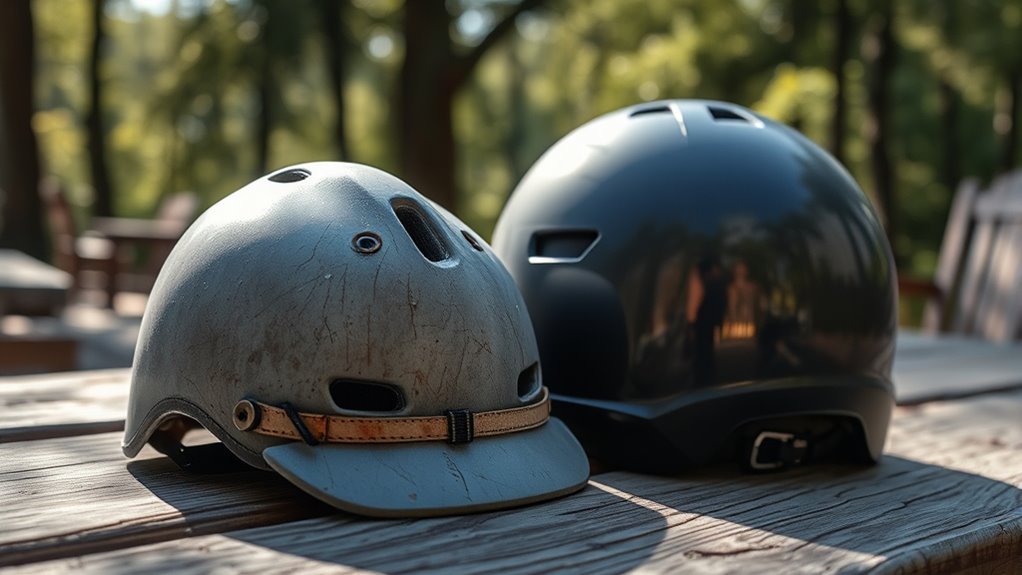
When it comes to safety gear, understanding your helmet’s lifespan is vital for ensuring ideal protection. Helmet technology has advanced considerably, but even the best helmets aren’t indestructible. Generally, a helmet should be replaced every 3 to 5 years, depending on the material durability and usage intensity. Factors like exposure to UV rays, temperature fluctuations, and general wear can degrade the materials, impacting their effectiveness. It’s important to familiarize yourself with the specifications provided by the manufacturer, as different materials have varying lifespans. Knowing when to replace your helmet empowers you to make informed choices, ensuring your safety while enjoying the freedom you seek. Prioritizing your helmet’s lifespan can ultimately enhance your riding experience and peace of mind.
Signs of Wear and Tear
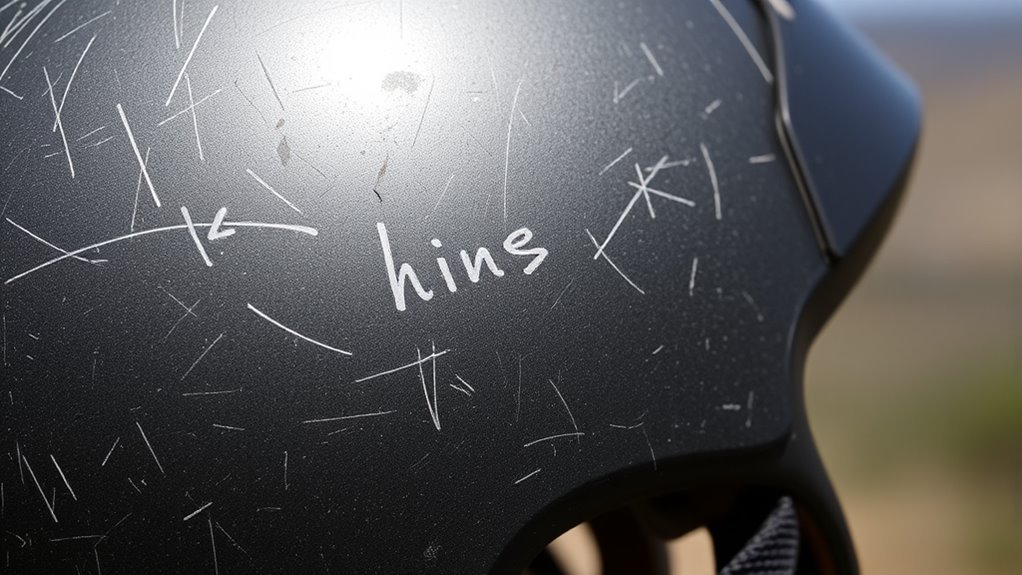
A helmet’s integrity can often be assessed by observing visible signs of wear and tear. If you notice any of the following, it might be time to replace your helmet:
- Cracks visibility: Look for any visible cracks on the outer shell. Even small ones can compromise safety.
- Padding deterioration: Check the inner padding for wear. If it’s compressed or falling apart, it won’t provide sufficient protection.
- Strap issues: Inspect the straps for fraying or looseness. They need to hold the helmet securely in place.
- Age: If your helmet’s over five years old, consider replacing it, even if it looks fine.
Keeping an eye on these signs guarantees you maintain peak safety while enjoying your freedom on the road or trail.
Impact Damage: When to Worry
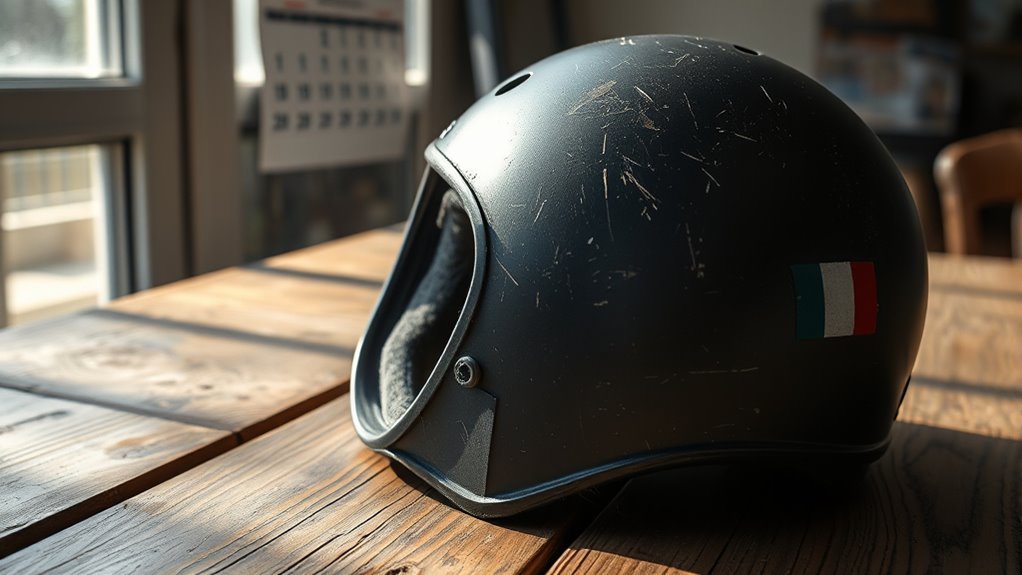
Even if your helmet appears intact, any impact should raise concern about its safety. It’s essential to understand that even minor impacts can compromise helmet integrity. Helmets are designed to absorb energy, and after an impact, their protective capabilities may be reduced. You should consider impact testing results: if your helmet has experienced a considerable hit, it’s wise to replace it. Look for visible signs of damage, such as cracks or dents, but also remember that the absence of these doesn’t guarantee safety. Regularly evaluate your helmet’s condition after each ride or activity. Prioritizing your safety means acknowledging that a helmet’s lifespan can be notably shortened by impact, so don’t hesitate to invest in a replacement when necessary.
The Importance of Manufacturing Dates
While it might be tempting to overlook the manufacturing date on your helmet, doing so can have serious implications for your safety. Understanding the date’s significance helps you make informed decisions about your gear. Helmets undergo specific manufacturing processes that affect their lifespan, and knowing when yours was made can guide you in evaluating its reliability.
Here are four reasons to pay attention to the manufacturing date:
- Material Degradation: Over time, materials break down, reducing impact protection.
- Safety Standards: Regulations change; older helmets may not meet current safety standards.
- Warranty Limitations: Most warranties expire after a certain period from the manufacturing date.
- Replacement Timelines: Recognizing the age helps establish when it’s time to replace your helmet.
Regular Maintenance and Inspection
Regular maintenance and inspection of your helmet are essential for guaranteeing its effectiveness in protecting you during an impact. To maintain your helmet’s integrity, perform regular checks for cracks, dents, or any signs of wear. Inspect the straps and buckles to verify they’re secure and functioning properly. Clean your helmet with mild soap and water, avoiding harsh chemicals that can degrade materials. Also, store it in a cool, dry place away from direct sunlight to prevent damage. Following these maintenance tips can prolong your helmet’s lifespan and guarantee it remains reliable. Remember, a well-maintained helmet not only enhances your safety but also maximizes your freedom to enjoy your activities with confidence. Stay proactive in your helmet care!
Specific Sports: Unique Replacement Guidelines
When participating in specific sports, understanding the unique replacement guidelines for your helmet is essential for ensuring ideal safety. Different activities impose distinct risks, which means your gear should match those challenges. Here’s a quick guide:
- Football helmets: Replace every 3-5 years, or after a significant impact.
- Cycling helmets: Replace every 3-5 years, especially after a crash, regardless of visible damage.
- Hockey helmets: Replace every 5 years and immediately if damaged.
- Skateboarding, climbing, and motocross helmets: Replace after any crash, as even minor impacts can compromise integrity.
Being proactive about helmet replacement not only enhances your safety but also gives you the freedom to enjoy your sport with confidence.
Helmet Standards and Certifications
Understanding helmet standards and certifications is essential for guaranteeing you choose a helmet that provides adequate protection. Different certification agencies conduct helmet testing to determine whether a helmet meets safety benchmarks. These standards, like CPSC in the U.S. or CE in Europe, guarantee your helmet can withstand impacts and reduce the risk of injury. When you’re selecting a helmet, look for labels that indicate compliance with these recognized standards. Remember, not all helmets are created equal; those that lack proper certification may not offer the level of protection you need. By prioritizing helmets with verified certifications, you’re not just making a purchase—you’re investing in your safety and freedom to ride or play with confidence.
How to Properly Dispose of an Old Helmet
When you’re ready to dispose of your old helmet, it’s vital to take into account the best methods for safe disposal and recycling. Many local recycling programs accept helmets, but guidelines can vary, so checking with your community is important. Additionally, proper disposal guarantees that the helmet doesn’t pose a hazard to others while promoting environmental responsibility.
Recycling Options Available
Many people don’t realize that properly disposing of an old helmet is just as important as wearing one. By recycling your helmet, you contribute to a sustainable future and minimize waste. Here are some recycling options to ponder:
- Check for Manufacturer Programs: Many brands offer recycling programs for their helmets, ensuring eco-friendly materials are reused.
- Local Recycling Initiatives: Look for community recycling events that accept helmets, promoting local environmental efforts.
- Specialized Recycling Facilities: Some facilities focus on recycling sports equipment; find one near you.
- Donation: If your helmet’s still in good condition, think about donating it to schools or organizations that can use it.
Safe Disposal Methods
After exploring recycling options for old helmets, it’s important to contemplate safe disposal methods for those that are beyond repair or no longer meet safety standards. Proper disposal not only protects your well-being but also reduces the environmental impact.
| Disposal Method | Description | Environmental Impact |
|---|---|---|
| Landfill | Tossing the helmet in the trash. | High, as it adds waste. |
| Incineration | Burning the helmet to reduce size. | Moderate, contributes to air pollution. |
| Repurposing | Using parts for DIY projects or crafts. | Low, promotes recycling. |
| Manufacturer Return | Check if the manufacturer offers a take-back program. | Low, guarantees proper recycling. |
Investing in a New Helmet: What to Consider
How do you know when it’s time to invest in a new helmet? Understanding your helmet’s fit and features is essential for your safety and comfort. Consider these factors before making your decision:
- Impact History: If your helmet has endured any significant impact, it’s time for a replacement.
- Wear and Tear: Inspect for cracks, dents, or worn padding that compromises protection.
- Outdated Technology: Helmets evolve with new safety standards; verify yours meets current regulations.
- Improper Fit: If your helmet no longer fits snugly or securely, it’s ineffective regardless of its condition.
Frequently Asked Questions
Can I Donate My Old Helmet to Charity?
You can’t typically donate your old helmet to charity, as most helmet donation guidelines discourage it due to safety concerns. Helmets can degrade over time and may not provide adequate protection. Instead, consider recycling old helmets at designated facilities that handle such materials. This way, you guarantee that your helmet’s materials are repurposed responsibly. Always check local resources for recycling options to contribute positively to the environment while keeping safety a priority.
What Materials Are Helmets Typically Made From?
Helmets are like a fortress for your head. Typically, they’re made from materials like polycarbonate, fiberglass, and expanded polystyrene foam, each playing an essential role in helmet construction. These materials help absorb impact and meet rigorous safety standards. Polycarbonate shells provide durability, while the foam liner guarantees comfort and protection. When choosing a helmet, understanding these components is critical for your safety and freedom on the road or trail.
How Can I Tell if a Helmet Is Counterfeit?
To spot a counterfeit helmet, look for counterfeit indicators like poor-quality materials, irregular logos, and inconsistent labeling. Check for safety certifications; genuine helmets meet specific standards. If the price seems too good to be true, it probably is. Inspect the padding and fit; authentic helmets prioritize comfort and protection. Remember, a counterfeit helmet jeopardizes your safety, so trust your instincts and invest in reputable brands to guarantee your freedom to ride safely.
Are There Helmets Specifically Designed for Women?
Yes, there are helmets specifically designed for women. These women’s helmet features often include tailored fit, lighter materials, and enhanced ventilation. Female-specific designs account for differences in head shape, offering better comfort and security. You’ll find options with adjustable straps and vibrant colors that reflect personal style, too. By choosing a helmet that aligns with these criteria, you’re not just prioritizing safety; you’re embracing freedom and individuality on your rides.
Can I Paint My Helmet for Customization?
Yes, you can paint your helmet for customization, but you need to be cautious. Many paints can compromise helmet safety by affecting the materials and structural integrity. Choose paint specifically designed for helmets or use decals to enhance helmet aesthetics without risking safety. Always guarantee any modifications don’t interfere with the helmet’s performance or certification. Remember, your protection is paramount, so prioritize safety while expressing your unique style.
